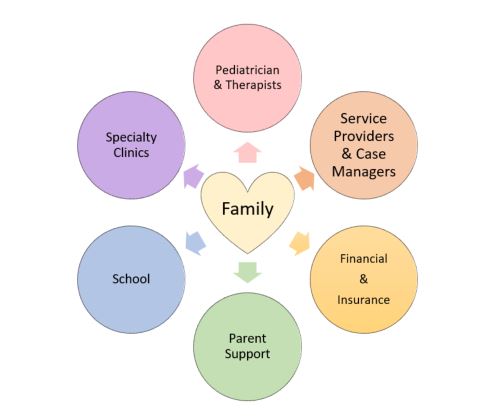Medical Home: A medical home isn’t a real “home” or place, it’s a philosophy of care that primary care physicians and healthcare systems are adopting to better serve their customers. The overall goal is that your child’s health and health information would have a physician or system that would “house” you and your medical history and provide overall coordination of care, which is especially important if your child has medical conditions that require frequent doctor visits to multiple physicians or specialty physicians.

The Regional Centers can support families to work with their medical providers to establish and support a medical home. We also help families with tools that promote a Medical Home, in partnership with the Wisconsin Medical Home Initiative including:
Care Mapping Training: A care map is a family-created diagram that visually maps out the complex web of services their child uses. Care maps help to integrate experiences of the family as well as their priorities for moving forward in the care for their child.
- Learn what a Care Map is
- How does a Care Map make your life easier?
- Start a Care Map for your child!!!
We can also team Care Mapping training with creating Care Notebooks. Care Binders or notebooks can serve as a spot to collect all of your children’s information and have it organized for appointments. We bring all the tools to make your own binder or portfolio and copies of different forms for you to use to personalize
- Find forms to keep track of key information
- Organize information from multiple doctors/ clinics in one place
- Track patterns and situations to better advocate for your child
What do we mean by Medical Home?
The following information is taken from the Patient-Centered Primary Care Collaborative. Adapted from the AHRQ definition, the PCPCC describes the medical home as an approach to the delivery of primary care that includes these 5 key points:
- Patient-centered: A partnership among practitioners, patients, and their families ensures that decisions respect patients’ wants, needs, and preferences, and that patients have the education and support they need to make decisions and participate in their own care.
- Comprehensive: A team of care providers is wholly accountable for a patient’s physical and mental health care needs, including prevention and wellness, acute care, and chronic care.
- Coordinated: Care is organized across all elements of the broader health care system, including specialty care, hospitals, home health care, community services and supports.
- Accessible: Patients are able to access services with shorter waiting times, “after hours” care, 24/7 electronic or telephone access, and strong communication through health IT innovations.
- Committed to quality and safety: Clinicians and staff enhance quality improvement to ensure that patients and families make informed decisions about their health.

Resources
- Well-Visit Planner-A great tool for your next visit with your child’s physician! In about 10 minutes or less you can get a personalized, printable Well-Visit Guide that you can present to your physician. The guide helps you remember the important issues you want to talk to your physician about and they can keep a copy in their file to do a check-in with you at your next visit.
- Wisconsin Medical Home Initiative Dedicated to promoting the concepts of medical home for primary care clinicians, families and service providers throughout Wisconsin. Their website provides up to date information on efforts in Wisconsin and includes archives
- The National Center for Medical Home Implementation An excellent web resource for health professionals and families.
- The Patient at Risk Program Wisconsin has more than 200,000 children with special health care needs. Many EMS providers have very limited pediatric experience responding to children with special needs in emergencies. EMS providers and responders could be better prepared to handle our medically fragile children if they know critical information before arriving on the scene. The Patient At Risk Program is an online database that allows families to enter specific information regarding their child to alert first responders about crucial medical information when an emergency call is placed.
Coordinating your Child’s Care
Family Voices offers online training available here
